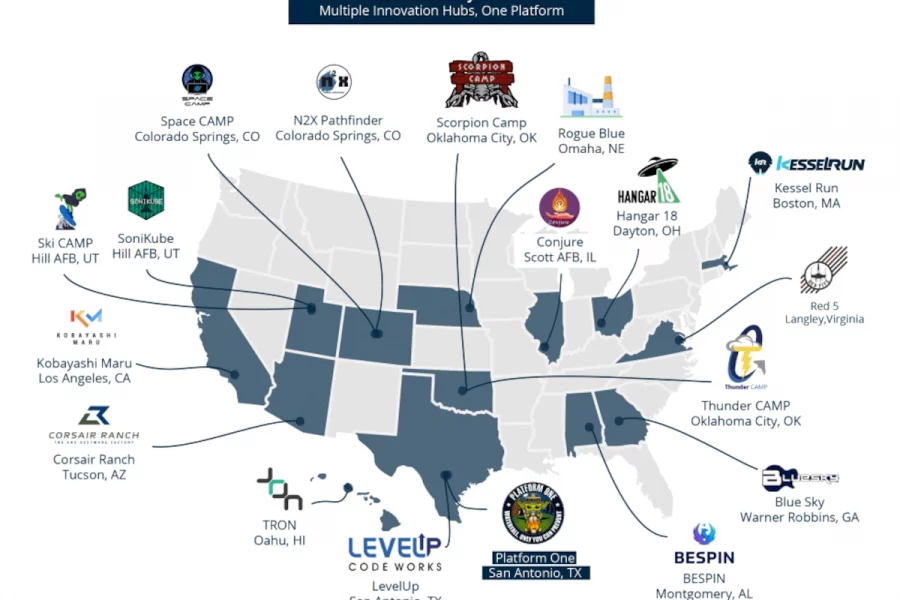DAYTON, Ohio—The Air Force’s network of software development teams has grown prodigiously in recent years, with 17 software factories, three software engineering groups, and two enterprise services spread across the U.S.
Now, however, USAF is reconsidering how it wants to organize those teams—having them work more closely together or possibly even consolidating them—as the principles behind them such as agile DevSecOps become more widely accepted across the service.
“The first intent was to consolidate the software engineering groups at Hill, Robins, and Tinker [Air Force Bases], and then in some way for that consolidated wing to have a relationship with the other software factories as we know them. That conversation is ongoing,” Steven Wert, program executive officer for the digital directorate, told reporters at the Life Cycle Industry Days conference.
As part of that conversation, “working groups [are] being established in different components, things like acquisitions and personnel and resiliency, for example,” said Col. Richard Lopez, materiel leader for the Air Force’s original software factory, Kessel Run.
“So you have different working groups, composed of different players within the ecosystem that are informing how the factories work together and collaborate together,” Lopez added.
Just how far-reaching those conversations will go or how long they will last, however, remains unclear, Wert said. Air Force Materiel Command has taken the lead on the process, which Wert described as a “bit confusing.”
“There are several well-known software factories like Kessel Run, and then there are others that are much less well known,” he said. “And then there are simply programs that are executing agile DevOps because it’s the right way to be doing software, and then they’re not known as software factories. So it’s not clear the extent to which this initiative … impacts various organizations.”
On top of that, there are considerations of how much the Air Force should rely on its software factories to develop capabilities versus simply buying and using commercial software. When Kessel Run first began in 2017, the Pentagon was notoriously slow at purchasing software, with technology often becoming outdated before the lengthy acquisition process was complete.
Against that backdrop, developing software in-house could be faster. But DOD has taken steps to try to speed up acquisition, introducing the Software Acquisition Pathway in 2020.
Kessel Run has already transitioned to using that pathway with its main customer, Air Combat Command. But the factory is also starting to buy commercial services itself, with applications such as C2IMERA.
“For the most part, the larger part of our portfolio uses a lot of internal development, or has historically used a lot of internal development, because Kessel Run started out as an experimental, government-led software development organization,” said Rodriguez, who took command in late June. “As we scale and expand, and as I’m further integrating into the program, what we’re doing is really taking a good look at the requirements that ACC gives us and then we make ‘buy versus build versus rent’ decisions so that we make sure that whatever it is that we’re delivering provides the best value for the warfighter.”
As the very first and arguably best known software factory, Kessel Run has already developed multiple applications that have seen real-world impact. In addition to C2IMERA for reporting, planning, force generation, emergency management, and command and control monitoring and execution, the factory has also developed KRADOS, which allows planners to build an air tasking order from anywhere using automation and advanced software.
KRADOS was first deployed to the Combined Air Operations Center at Al Udeid Air Base, Qatar, in early 2021, with early operational uses following at the 609th Air Operations Center. Recently, the system reached another milestone.
“Over the last week, we have delivered to our test organization a version of KRADOS [minimum viable capability release] that has achieved parity with TBMCS … the current system that’s being used,” Rodriguez said. “So the next step is to complete a final assessment with users at the actual AOC at Al Udied to determine … where that then becomes a system that the warfighters at the [Combined Air Operations Center] are using.”
Elements of KRADOS have also been used at the 603rd Air Operations Center at Ramstein Air Base, Germany, “primarily for visualization purposes and not necessarily developing the [air tasking order] and the airspace control order,” Rodriguez added, and the goal is to expand KRADOS so that it replaces the current system, the Theater Battle Management Core System (TBMCS), across the entire AOC enterprise.
First, however, KRADOS must undergo an assessment at the 609th AOC, split between Al Udied and Shaw Air Force Base, S.C. Teams will deploy to those bases to start that assessment in September, Rodriguez said. After that, it will be up to ACC to make a final call.

